Introduction of Cable Trays
Introduction:
Today cable trays have become a necessary part of industrial and commercial construction by offering quick, economical and flexible solutions to these problems. Cable trays are capable of supporting all types of wiring:
1. High Voltage Power Lines.
2. Power Distribution Cables
3. Sensitive Control Wiring
4. Telecommunication Wiring
5. Optical Cables
Cable Tray Materials:
Most cable tray systems are fabricated from a corrosion-resistant metal (low-carbon steel, stainless steel or an aluminium alloy) or from a metal with a corrosion-resistant finish (zinc or epoxy).
The choice of material for any particular installation depends on the installation environment (corrosion and electrical considerations) and cost.
(1) Aluminium:
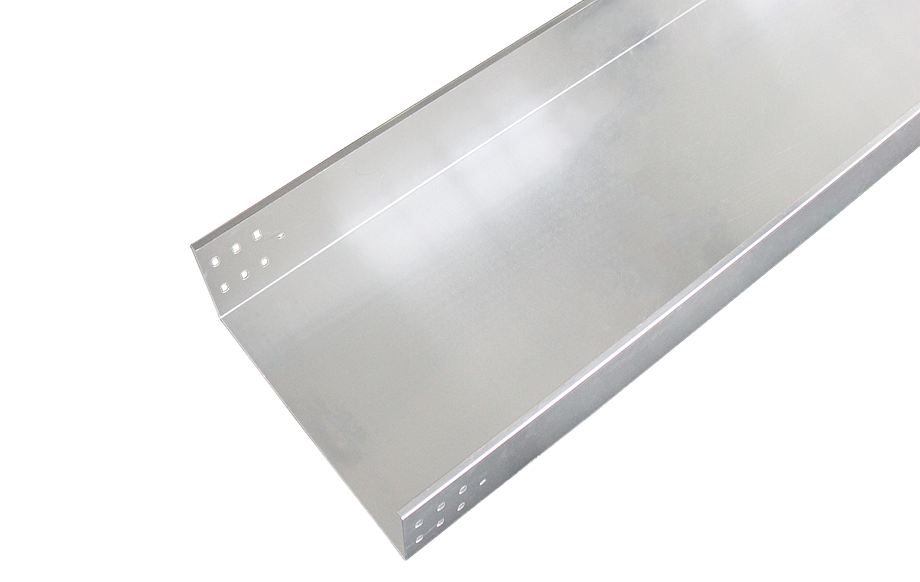
Cable trays fabricated of extruded aluminium are often used for their high strength-to-weight ratio, superior resistance to certain corrosive environments, and ease of installation. They also offer the advantages of being light weight (approximately 50% that of a steel tray) and maintenance free, and since aluminium cable trays are non-magnetic, electrical losses are reduced to a minimum.
Cable tray products are formed from the 6063 series alloys which by design are copper free alloys for marine applications. These alloys contain silicon and magnesium in appropriate proportions to form magnesium silicate, allowing them to be heat treated. These magnesium silicon alloys possess good formability and structural properties, as well as excellent corrosion resistance.
The unusual resistance to corrosion, including weathering, exhibited by aluminium is due to the self-healing aluminium oxide film that protects the surface. Aluminium’s resistance to chemicals in the application environment should be tested before installation.
(2) Galvanized Steel:
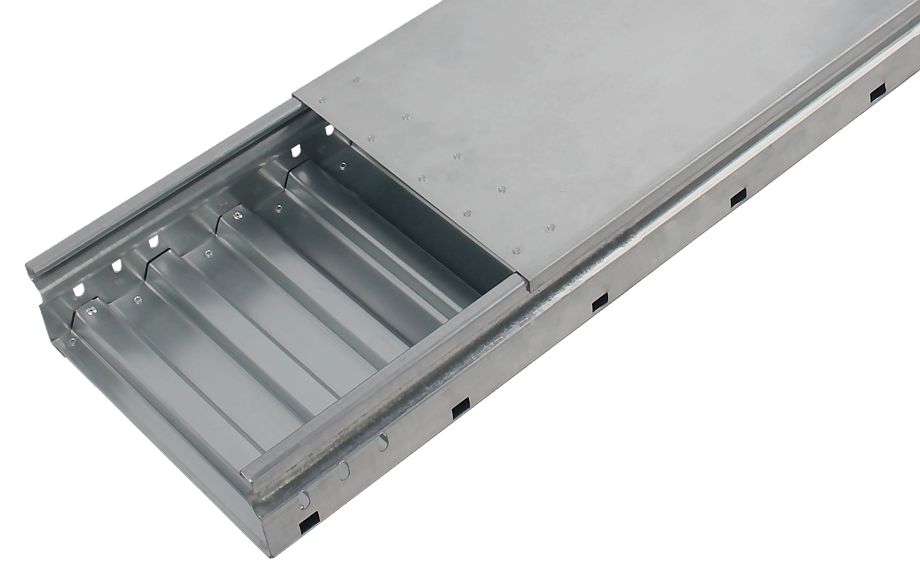
Galvanized Steel cable trays are fabricated from structural quality steels using a continuous roll-formed process. Forming and extrusions increase the mechanical strength.
The main benefits of steel cable tray are its high strength and low cost. Disadvantages include high weight, low electrical conductivity and relatively poor corrosion resistance.
The rate of corrosion will vary depending on many factors such as the environment, coating or protection applied and the composition of the steel. T&B offers finishes and coatings to improve the corrosion resistance of steel. These include pre-galvanized, hot dip galvanized (after fabrication), epoxy and special paints.
(3) Stainless Steel:
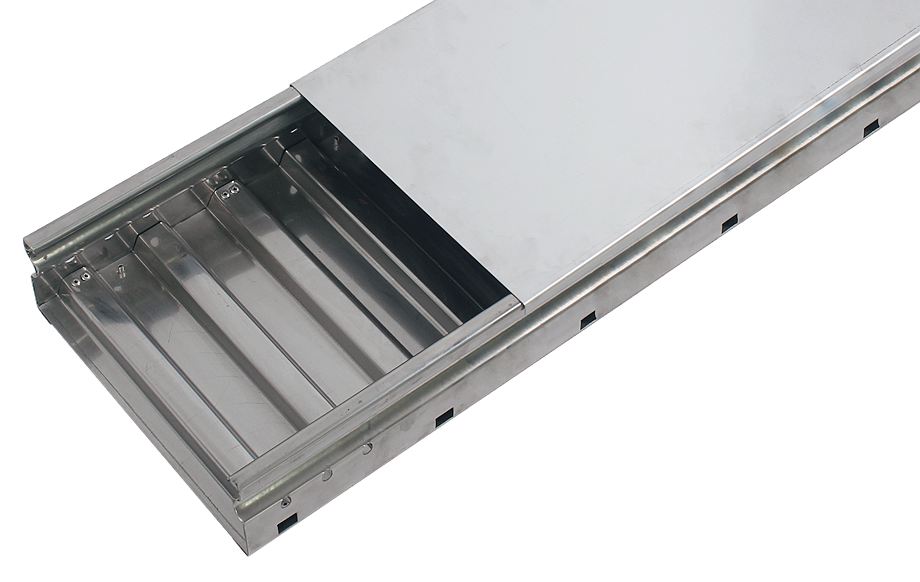
Stainless steel offers high yield strength and high creep strength, at high ambient temperatures.
Stainless steel cable tray is roll-formed from AISI Type 316 stainless steel.
Stainless Steel is resistant to dyestuffs, organic chemicals, and inorganic chemicals at elevated temperatures. Higher levels of chromium and nickel and a reduced level of carbon serve to increase corrosion resistance and facilitate welding. Type 316 includes molybdenum to increase high temperature strength and improve corrosion resistance, especially to chloride and sulfuric acid. Carbon content is reduced to facilitate welding.
Finishing of Cable Tray
(1) Galvanized Coatings

The most widely used coating for cable tray is galvanizing. It is cost-effective, protects against a wide variety of environ mental chemicals, and is self-healing if an area becomes unprotected through cuts or scratches.
Steel is coated with zinc through electrolysis by dipping steel into a bath of zinc salts. A combination of carbonates, hydroxides and zinc oxides forms a protective film to protect the zinc itself. Resistance to corrosion is directly related to the thickness of the coating and the harshness of the environ ment.
(2) Pre-Galvanized:
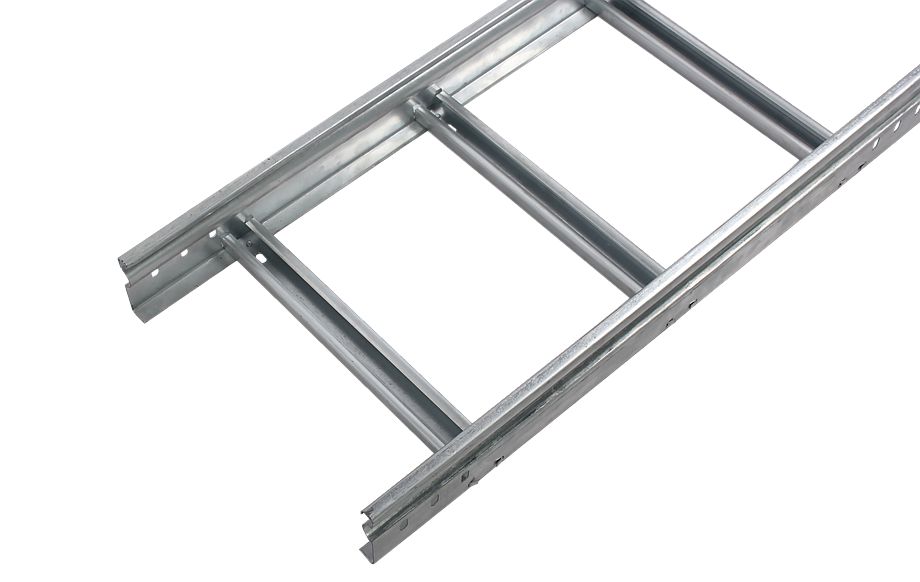
Pre-galvanized, also known as mill-galvanized or hot dip mill-galvanized, is produced in a rolling mill by passing steel coils through molten zinc. These coils are then slit to size and fabricated.
Areas not normally coated during fabrication, such as cuts and welds, are protected by neighboring zinc, which works as a sacrificial anode. During welding, a small area directly affected by heat is also left bare, but the same self-healing process occurs.
G90 requires a coating of .90 ounces of zinc per square foot of steel, or .32 ounces per square foot on each side of the metal sheet. In accordance with A653/A653M-06a, pre-galvanized steel is not generally recommended for outdoor use or in industrial environments.
(3) Hot-Dip Galvanized:
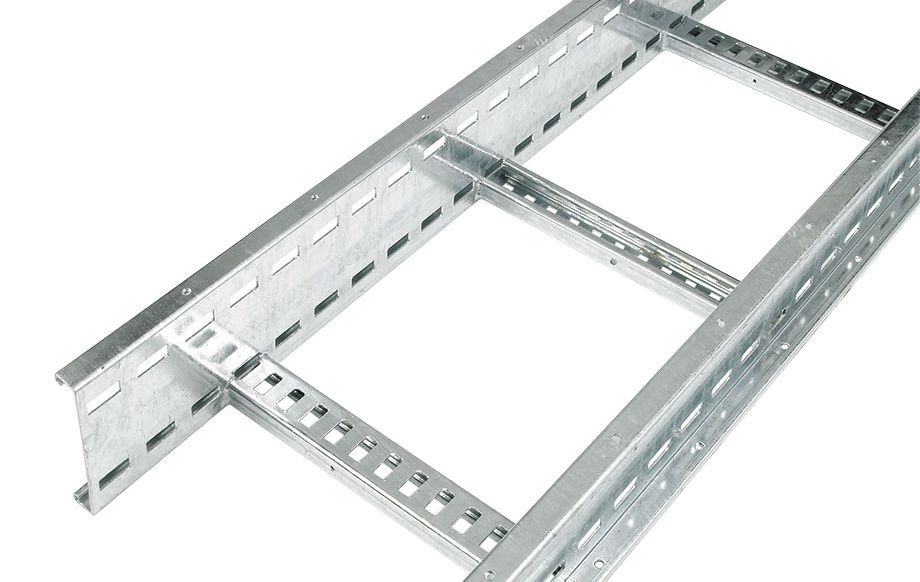
After the steel cable tray has been manufactured and assem bled, the entire tray is immersed in a bath of molten zinc, resulting in a coating of all surfaces, as well as all edges, holes and welds.
Coating thickness is determined by the length of time each part is immersed in the bath and the speed of removal. Hot dip galvanizing after fabrication creates a much thicker coating than the pre-galvanized process, a minimum of 3.0 ounces per square foot of steel or 1.50 ounces per square foot on each side of the sheet (according to ASTMA123,grade 65).
The process is recommended for cable tray used in most outdoor environments and many harsh industrial environment applications.
Type of Cable Trays:
Cable trays are made of either steel, aluminium or fibber reinforced plastic (FRP) and are available in six basic types,
1. Ladder Type Cable Tray
2. Solid Cable Tray
3. Ventilated Cable Tray
(1) Ladder Cable Tray
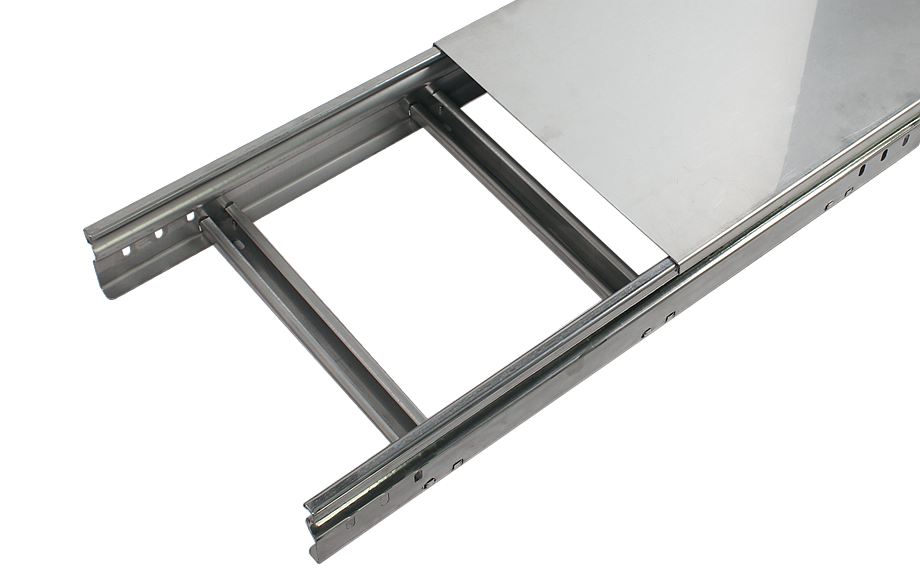
Generally used in applications with intermediate to long support spans 12 to 30 feet.
Ladder cable tray is used for about 75 percent of the cable tray wiring system installations. It is the predominate cable tray type due to its many desirable features:
A ladder cable tray without covers permits the maximum free flow of air across the cables. This allows the heat produced in the cable’s conductors to effectively dissipate. Under such conditions, the conductor insulation in the cables of a properly designed cable tray wiring system will not exceed its maximum operating temperature. The cables will not prematurely age due to excessive operating temperatures.
The rungs of the ladder cable trays provide convenient anchors for tying down the cables in the non-horizontal cable tray runs or where the positions of the cables must be maintained in the horizontal cable tray runs. This capability is a must for single conductor cable installations. Under fault conditions (short circuit), the magnetic forces produced by the fault current will force the single conductor cables from the cable tray if they are not securely anchored to the cable tray.
Cables may exit or enter the ladder cable trays through the top or the bottom of the cable tray. Where the cables enter or exit conduit, the conduit to cable tray clamps may be installed upright or inverted to terminate conduits on the top or bottom of the cable tray side rail.
Moisture can’t accumulate in ladder cable trays
If cable trays are being installed where working space is a problem, hand access through the cable tray bottom may help to facilitate the installation of small diameter cables: control instrumentation, signal, etc.
The most common rung spacing for ladder cable tray is 9 inches. This spacing may be used to support all sizes of cables. This spacing is desirable for the small diameter Type PLTC and TC cables as the support distance is such that there is no visible drooping of the small cables between rungs. 12 or 18 inch rung spacing provides adequate cable support but the slight amount of small diameter cable drooping between rungs may be aesthetically objectionable for some installations. The maximum allowable distance between supports for 1/0 through 4/0 AWG single conductor cables is 9 inches [1993 NEC Section 318-3(b) (1)].
Ventilated Trough Cable Tray
The only reason to select a ventilated trough cable tray over a ladder type cable tray is aesthetics. No drooping of small cables is visible. The ventilated trough cable tray does provide more support to the cables than does the ladder cable tray but this additional support is not significant. It doesn’t have any impact on the cables service record or life.
Characteristics:
Solid side rail protection and system strength with smooth radius fittings.
Maximum strength for long span applications
Standard widths of 6, 12, 18, 24, 30 & 36 inches
Standard depths of 3, 4, 5 & 6 inches
Standard lengths of 10, 12, 20 & 24 feet
Rung spacing of 6, 9, 12 & 18 inches.
(2) Solid Cable Tray:

Generally used for minimal heat generating electrical or telecommunication applications with short to intermediate support spans 5 to 12 feet.
The main reason for selecting solid bottom cable tray (with covers) is the concern of EMI/ RFI shielding protection for very sensitive circuits. A solid bottom steel cable tray with steel covers provides a good degree of shielding if there are no breaks or holes in the completed installation.
The solid bottom cable tray system has a disadvantage in that moisture can build up in the cable trays. This can be controlled by drilling 1/4 inch drain holes in the bottom of the cable tray at three foot intervals (at the middle and very near the sides) if the cable tray is not being used for EMI/RFI shielding.
Some engineers and designers specify solid bottom cable trays (often with covers) in the belief that all electrical circuits have to be totally enclosed by metal. The cable trays are just supporting cables that are designed for such installations. Cable failures in cable tray runs rarely happen. Cable failures due to cable support problems in cable trays are nonexistent.
Characteristics:
Non-ventilated continuous support for delicate cables with added cable protection available in metallic and fiberglass
Solid bottom metallic with solid metal covers for non-plenum rated cable in environmental areas
Standard widths of 6, 12, 18, 24, 30 & 36 inches
Standard depths of 3, 4, 5 & 6 inches
Standard lengths of 10, 12, 20 & 24 feet.
(3) Ventilated Cable Tray
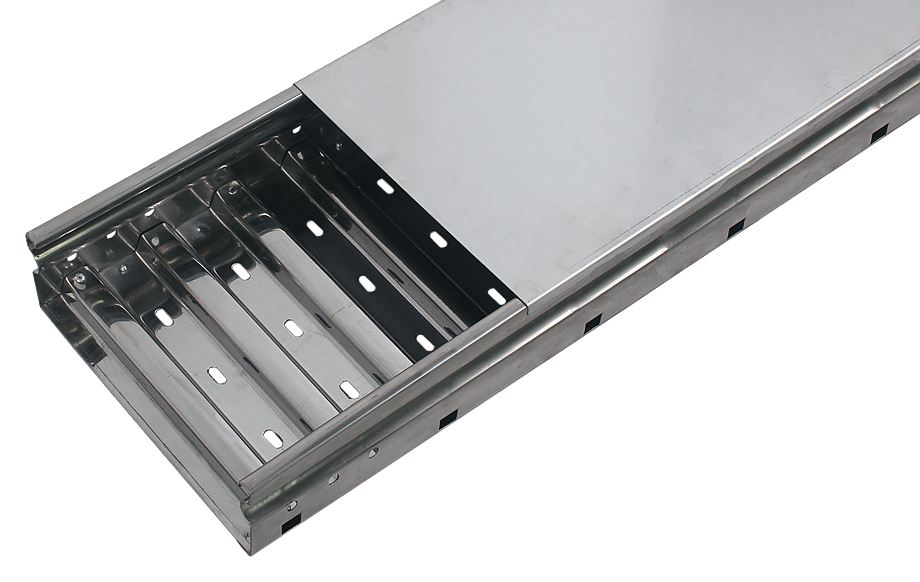
We are offering our clients a wide array of Ventilated Cable Trays in bulk as per their demands and requirement. These Ventilated Cable Trays has its wide applications in various industrial applications and in varied other purposes. These Ventilated Cable Trays are light in weight and are offered to our clients in various sizes and designs. These Ventilated Cable Trays requires very less maintenance and can be availed by our customers at very reasonable rates.
Characteristics:
• Light in weight
• Cost effective
• No maintenance cost




 Solid Corrugated Cable Tray
Solid Corrugated Cable Tray Perforated Corrugated Cable Tray
Perforated Corrugated Cable Tray Ladder Corrugated Cable Tray
Ladder Corrugated Cable Tray




